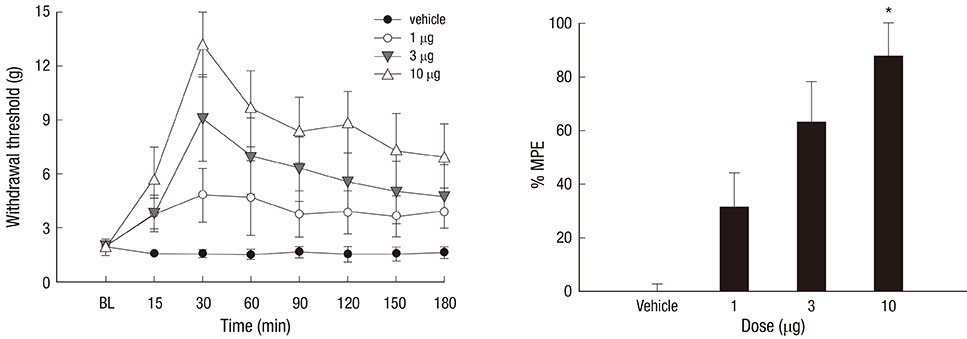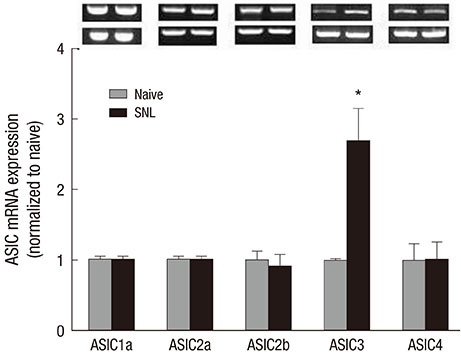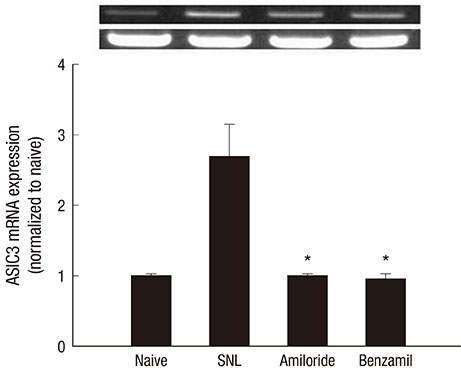J Korean Med Sci.
2013 Aug;28(8):1238-1243. 10.3346/jkms.2013.28.8.1238.
Antinociceptive Effects of Amiloride and Benzamil in Neuropathic Pain Model Rats
- Affiliations
-
- 1Department of Anesthesiology and Pain Medicine, Chonnam National University, Medical School, Gwangju, Korea. mhyoon@jnu.ac.kr
- 2Brain Korea 21 Project, Center for Biomedical Human Resources at Chonnam National University, Gwangju, Korea.
- 3Chonnam National University Research Institute of Medical Sciences, Gwangju, Korea.
- KMID: 1793032
- DOI: http://doi.org/10.3346/jkms.2013.28.8.1238
Abstract
- Amiloride and benzamil showed antinocicepitve effects in several pain models through the inhibition of acid sensing ion channels (ASICs). However, their role in neuropathic pain has not been investigated. In this study, we investigated the effect of the intrathecal amiloride and benzamil in neuropathic pain model, and also examined the role of ASICs on modulation of neuropathic pain. Neuropathic pain was induced by L4-5 spinal nerve ligation in male Sprague-Dawley rats weighing 100-120 g, and intrathecal catheterization was performed for drug administration. The effects of amiloride and benzamil were measured by the paw-withdrawal threshold to a mechanical stimulus using the up and down method. The expression of ASICs in the spinal cord dorsal horn was also analyzed by RT-PCR. Intrathecal amiloride and benzamil significantly increased the paw withdrawal threshold in spinal nerve-ligated rats (87%+/-12% and 76%+/-14%, P=0.007 and 0.012 vs vehicle, respectively). Spinal nerve ligation increased the expression of ASIC3 in the spinal cord dorsal horn (P=0.01), and this increase was inhibited by both amiloride and benzamil (P<0.001 in both). In conclusion, intrathecal amiloride and benzamil display antinociceptive effects in the rat spinal nerve ligation model suggesting they may present an alternative pharmacological tool in the management of neuropathic pain at the spinal level.
Keyword
MeSH Terms
-
Acid Sensing Ion Channels/genetics/metabolism
Amiloride/*analogs & derivatives/pharmacology/*therapeutic use
Analgesics/pharmacology/*therapeutic use
Animals
Disease Models, Animal
Male
Neuralgia/*drug therapy
RNA, Messenger/metabolism
Rats
Rats, Sprague-Dawley
Reverse Transcriptase Polymerase Chain Reaction
Spinal Cord/metabolism
Transcription, Genetic/drug effects
Acid Sensing Ion Channels
Amiloride
Analgesics
RNA, Messenger
Figure
Cited by 1 articles
-
A New Rat Model of Cisplatin-induced Neuropathic Pain
Hai Lin, Bong Ha Heo, Myung Ha Yoon
Korean J Pain. 2015;28(4):236-243. doi: 10.3344/kjp.2015.28.4.236.
Reference
-
1. Treede RD, Jensen TS, Campbell JN, Cruccu G, Dostrovsky JO, Griffin JW, Hansson P, Hughes R, Nurmikko T, Serra J. Neuropathic pain: redefinition and a grading system for clinical and research purposes. Neurology. 2008; 70:1630–1635.2. Wallace JM. Update on pharmacotherapy guidelines for treatment of neuropathic pain. Curr Pain Headache Rep. 2007; 11:208–214.3. Rocha-González HI, Castañeda-Corral G, Araiza-Saldaña CI, Ambriz-Tututi M, Caram-Salas NL, Torres-López JE, Murbartián J, Granados-Soto V. Identification of the Na+/H+ exchanger 1 in dorsal root ganglion and spinal cord: its possible role in inflammatory nociception. Neuroscience. 2009; 160:156–164.4. Page AJ, Brierley SM, Martin CM, Hughes PA, Blackshaw LA. Acid sensing ion channels 2 and 3 are required for inhibition of visceral nociceptors by benzamil. Pain. 2007; 133:150–160.5. Ugawa S, Ueda T, Ishida Y, Nishigaki M, Shibata Y, Shimada S. Amiloride-blockable acid-sensing ion channels are leading acid sensors expressed in human nociceptors. J Clin Invest. 2002; 110:1185–1190.6. Colombo E, Francisconi S, Faravelli L, Izzo E, Pevarello P. Ion channel blockers for the treatment of neuropathic pain. Future Med Chem. 2010; 2:803–842.7. Krishtal O. The ASICs: signaling molecules? modulators? Trends Neurosci. 2003; 26:477–483.8. Dubé GR, Elagoz A, Mangat H. Acid sensing ion channels and acid nociception. Curr Pharm Des. 2009; 15:1750–1766.9. Wu LJ, Duan B, Mei YD, Gao J, Chen JG, Zhuo M, Xu L, Wu M, Xu TL. Characterization of acid-sensing ion channels in dorsal horn neurons of rat spinal cord. J Biol Chem. 2004; 279:43716–43724.10. Mazzuca M, Heurteaux C, Alloui A, Diochot S, Baron A, Voilley N, Blondeau N, Escoubas P, Gélot A, Cupo A, et al. A tarantula peptide against pain via ASIC1a channels and opioid mechanisms. Nat Neurosci. 2007; 10:943–945.11. Duan B, Wu LJ, Yu YQ, Ding Y, Jing L, Xu L, Chen J, Xu TL. Upregulation of acid-sensing ion channel ASIC1a in spinal dorsal horn neurons contributes to inflammatory pain hypersensitivity. J Neurosci. 2007; 27:11139–11148.12. Zimmermann M. Ethical guidelines for investigations of experimental pain in conscious animals. Pain. 1983; 16:109–110.13. Kim SH, Chung JM. An experimental model for peripheral neuropathy produced by segmental spinal nerve ligation in the rat. Pain. 1992; 50:355–363.14. Calcutt NA, Jorge MC, Yaksh TL, Chaplan SR. Tactile allodynia and formalin hyperalgesia in streptozotocin-diabetic rats: effects of insulin, aldose reductase inhibition and lidocaine. Pain. 1996; 68:293–299.15. Yaksh TL, Rudy TA. Chronic catheterization of the spinal subarachnoid space. Physiol Behav. 1976; 17:1031–1036.16. Chaplan SR, Bach FW, Pogrel JW, Chung JM, Yaksh TL. Quantitative assessment of tactile allodynia in the rat paw. J Neurosci Methods. 1994; 53:55–63.17. Tallarida RJ. Drug synergism and dose-effect data analysis. New York: Chapman & Hall/CRC;2000.18. Lee HG, Park SK, Yoon MH. Potentiation of morphine antiallodynic efficacy by ACPT-III, a group III metabotropic glutamate receptor agonist, in rat spinal nerve ligation-induced neuropathic pain. Pharmacol Biochem Behav. 2010; 96:108–113.19. Kellenberger S, Schild L. Epithelial sodium channel/degenerin family of ion channels: a variety of functions for a shared structure. Physiol Rev. 2002; 82:735–767.20. Lingueglia E. Acid-sensing ion channels in sensory perception. J Biol Chem. 2007; 282:17325–17329.21. Rocha-González HI, Herrejon-Abreu EB, López-Santillán FJ, García-López BE, Murbartián J, Granados-Soto V. Acid increases inflammatory pain in rats: effect of local peripheral ASICs inhibitors. Eur J Pharmacol. 2009; 603:56–61.22. Walder RY, Rasmussen LA, Rainier JD, Light AR, Wemmie JA, Sluka KA. ASIC1 and ASIC3 play different roles in the development of hyperalgesia after inflammatory muscle injury. J Pain. 2010; 11:210–218.23. Wultsch T, Painsipp E, Shahbazian A, Mitrovic M, Edelsbrunner M, Lazdunski M, Waldmann R, Holzer P. Deletion of the acid-sensing ion channel ASIC3 prevents gastritis-induced acid hyperresponsiveness of the stomach-brainstem axis. Pain. 2008; 134:245–253.24. Baron A, Voilley N, Lazdunski M, Lingueglia E. Acid sensing ion channels in dorsal spinal cord neurons. J Neurosci. 2008; 28:1498–1508.25. Matricon J, Gelot A, Etienne M, Lazdunski M, Muller E, Ardid D. Spinal cord plasticity and acid-sensing ion channels involvement in a rodent model of irritable bowel syndrome. Eur J Pain. 2011; 15:335–343.26. Hruska-Hageman AM, Benson CJ, Leonard AS, Price MP, Welsh MJ. PSD-95 and Lin-7b interact with acid-sensing ion channel-3 and have opposite effects on H+- gated current. J Biol Chem. 2004; 279:46962–46968.27. Deval E, Noël J, Lay N, Alloui A, Diochot S, Friend V, Jodar M, Lazdunski M, Lingueglia E. ASIC3, a sensor of acidic and primary inflammatory pain. EMBO J. 2008; 27:3047–3055.28. Ikeuchi M, Kolker SJ, Sluka KA. Acid-sensing ion channel 3 expression in mouse knee joint afferents and effects of carrageenan-induced arthritis. J Pain. 2009; 10:336–342.29. Sluka KA, Radhakrishnan R, Benson CJ, Eshcol JO, Price MP, Babinski K, Audette KM, Yeomans DC, Wilson SP. ASIC3 in muscle mediates mechanical, but not heat, hyperalgesia associated with muscle inflammation. Pain. 2007; 129:102–112.30. Yuan FL, Chen FH, Lu WG, Li X. Acid-sensing ion channels 3: a potential therapeutic target for pain treatment in arthritis. Mol Biol Rep. 2010; 37:3233–3238.31. Borzan J, Zhao C, Meyer RA, Raja SN. A role for acid-sensing ion channel 3, but not acid-sensing ion channel 2, in sensing dynamic mechanical stimuli. Anesthesiology. 2010; 113:647–654.32. Alexander SP, Mathie A, Peters JA. Guide to Receptors and Channels (GRAC), 3rd edition. Br J Pharmacol. 2008; 153:S1–S209.33. Craner MJ, Hains BC, Lo AC, Black JA, Waxman SG. Co-localization of sodium channel Nav1.6 and the sodium-calcium exchanger at sites of axonal injury in the spinal cord in EAE. Brain. 2004; 127:294–303.34. Stys PK, Waxman SG, Ransom BR. Ionic mechanisms of anoxic injury in mammalian CNS white matter: role of Na+ channels and Na(+)-Ca2+ exchanger. J Neurosci. 1992; 12:430–439.35. Muthuraman A, Jaggi AS, Singh N, Singh D. Ameliorative effects of amiloride and pralidoxime in chronic constriction injury and vincristine induced painful neuropathy in rats. Eur J Pharmacol. 2008; 587:104–111.36. Jagodic MM, Pathirathna S, Joksovic PM, Lee W, Nelson MT, Naik AK, Su P, Jevtovic-Todorovic V, Todorovic SM. Upregulation of the T-type calcium current in small rat sensory neurons after chronic constrictive injury of the sciatic nerve. J Neurophysiol. 2008; 99:3151–3156.37. Todorovic SM, Meyenburg A, Jevtovic-Todorovic V. Mechanical and thermal antinociception in rats following systemic administration of mibefradil, a T-type calcium channel blocker. Brain Res. 2002; 951:336–340.38. Wen XJ, Xu SY, Chen ZX, Yang CX, Liang H, Li H. The roles of T-type calcium channel in the development of neuropathic pain following chronic compression of rat dorsal root ganglia. Pharmacology. 2010; 85:295–300.39. Li WG, Yu Y, Zhang ZD, Cao H, Xu TL. ASIC3 channels integrate agmatine and multiple inflammatory signals through the nonproton ligand sensing domain. Mol Pain. 2010; 6:88.40. Yu Y, Chen Z, Li WG, Cao H, Feng EG, Yu F, Liu H, Jiang H, Xu TL. A nonproton ligand sensor in the acid-sensing ion channel. Neuron. 2010; 68:61–72.
- Full Text Links
- Actions
-
Cited
- CITED
-
- Close
- Share
- Similar articles
-
- Antinociceptive Effects of Amikacin on Neuropathic Pain in Rats
- Antinociceptive Effects of Tramadol on the Neuropathic Pain in Rats
- Antinociceptive and neuroprotective effects of bromelain in chronic constriction injury-induced neuropathic pain in Wistar rats
- Antinociceptive Effect of Memantine and Morphine on Vincristine-induced Peripheral Neuropathy in Rats
- Effect of subcutaneous treatment with human umbilical cord blood-derived multipotent stem cells on peripheral neuropathic pain in rats





